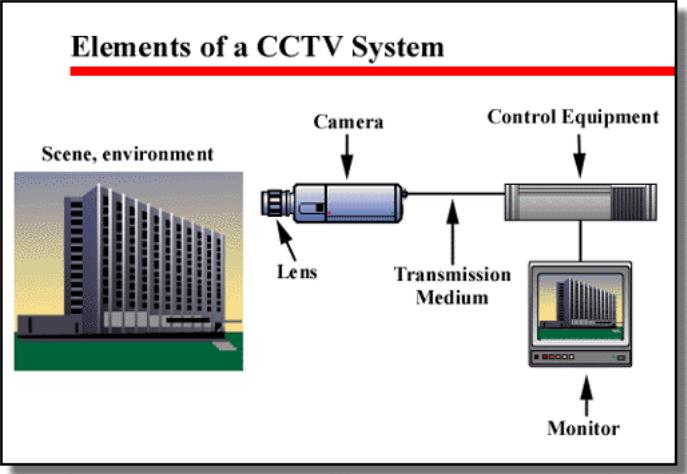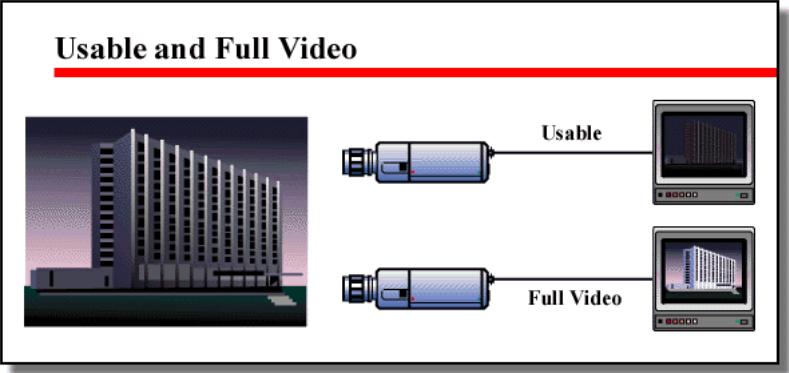
- •In which cctv (Closed Circuit Television) offers distinct
- •Light Quality
- •Light Quantity
- •Measuring the Quantity of Light
- •Indicating the amount of light which is actually transmitted
- •Calculating Light Levels
- •Improved life cycle
- •Camera Compensation for Extremes in Light Levels
- •Synchronization
- •Genlock
- •Covering the Scene
- •Focal Length and Field of View
- •Image Size and Focal Length
- •Monitors - Human Interface Factors
- •In addition to the items presented in the example, the design criteria will evolve to include specifications for monitors.
- •System Management
- •Designing a New System
CCTV Systems and Control Design
CCTV Systems and Control Design
.It covers the application criteria, design elements, components and
requirements necessary in the design of an effective CCTV system.
Learning Objective
After completing these studies, you should be able to:
describe situations in which CCTV systems offer distinct advantages for
surveillance
identify the six (6) design elements to consider when designing a CCTV system
list and describe the three (3) related quantities when considering light levels
describe the process of measuring quantities of light and define the factors
involved
recognize calculations to determine light levels and reflected light requirements
list advantages of CCD (Charge-Coupled Device) image sensors
list and compare the most common CCD technologies
identify the seven (7) factors to consider when selecting a camera
define the three (3) factors determining image size
given a chart and examples of image sizes and distances, determine the
appropriate focal length specify formulas used in calculating focal length and image width and height given the appropriate camera focal length, select the required CCTV monitor identify the questions to ask customers about system function, system management and system when planning a CCTV system
given a set of customer requirements, select an appropriate camera configuration and transmission medium for the application.
CCTV System Application Criteria
Effective CCTV System Applications
A remote corner of a parking lot requires security coverage 24
hours a day, year round. A warehouse storing high explosives
demands constant surveillance. These are just two situations
In which cctv (Closed Circuit Television) offers distinct
advantages in providing surveillance. There are many other
situations as well, and in Book 4 of the PACE series on
Security Basics, we will examine the necessary steps in
designing an effective CCTV application.
Human observers are costly and valuable resources. CCTV
allows security managers to use this resource judiciously.
There are a number of common situations where human
safety, concealed observation, or resource management are
better served with CCTV rather than human observers. These
situations include:
Observation of remote areas (parking lots, garages)
Observation of hazardous areas (radioactive waste dumps,
chemical storage areas)
Discreet or concealed observation (loading docks, lobby
areas)
Sustained observation of areas with infrequent activity
(warehouses, rail yards)
Simultaneous observation of multiple areas (high-rise

CCTV Design Elements
Elements of a CCTV System
Designing a CCTV system requires the planner to fit a number
of important pieces together. Individually, these pieces are
crucial, but how they interact with every other piece is just as
important. As suggested in Figure 4-2, there are six (6) design
elements to consider when designing any CCTV system:
scene, environment camera lens transmission medium monitor
Video Signal Management and Control Equipment
To review, the scene is the area of surveillance — the area
which is to be observed and its environment. This includes
lighting, weather, security of the CCTV equipment and the
detail desired of the picture displayed by the monitors.
The lens is the optical component of the system which
"defines" the image of the screen — its size, shape and focus.

Lighting Requirements
The scene is the place where all design decisions start, and no aspect of
the scene is more important that light — quality and quantity. Without
proper lighting, cameras cannot perform adequately, that is, provide
usable images. A key issue in designing a CCTV security application is
evaluating current lighting conditions in the area of interest, determining
what, if any, additional light sources may be required, and asking "what
does the customer want to see?"
Usable and Full Video
Usable is a term often applied to video. Another common term
is full video. Both usable and full are somewhat subjective:
what is "usable" to one person, may not be to another. The
terms (Figure 4-3) describe for video what fidelity describes for
audio recordings. A child' tape recorder and a recording studio
Digital Audio Tape (DAT) recorder may be able to record the
same sounds, but the child's toy will be noisy, with a limited
frequency range. Much of the sound (the lows and highs, for
example) will be missing; on the other hand, the DAT
recording will sound "like you're there." A similar qualitative
difference exists, between usable and full video.
In general, usable video (or usable image) refers to video
images which supply the minimum level of information
required by an application. Full video is perhaps the less
subjective of the two terms. It refers to images which
reproduce the scene with a high level of "fidelity" — it appears
on screen substantially as it does in actuality.
Usable or full video is only possible with proper illumination.
Clearly, light levels in a scene must be high enough to
produce usable video at a minimum. In situations with minimal
light levels, ideally, additional light would be added to permit
full video from the camera. If lighting levels are inadequate for
a given camera, designers have two options:
add light
select a camera with greater sensitivity
Which option is chosen may depend on several factors
including the cost of changing the camera vs. the cost of
supplementing existing lighting.

